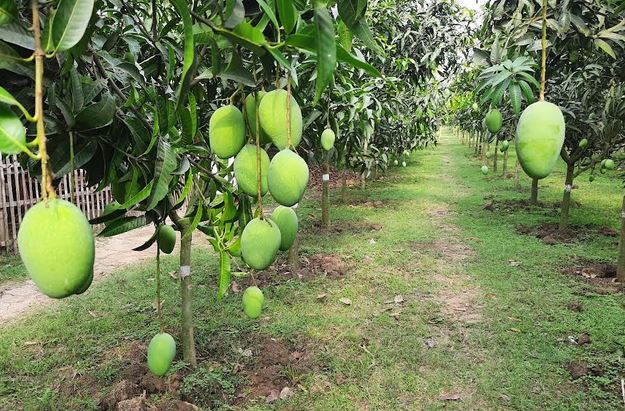News Flash

By Md Aynal Haque
RAJSHAHI, June 28, 2025 (BSS) - Rajshahi is poised to become a hub for mango processing industries, driven by its massive mango output and growing market demand for processed fruit products. Experts say the region's dominance in mango production and favorable conditions offer a strong foundation for agro-industrial investment.
The region alone produces 49 percent of the country's total mango production and there is an ample opportunity for establishing mango-based industries here.
Dr Alim Uddin, former chief scientific officer at Regional Fruit Research Station, said Rajshahi, along with its adjacent Naogaon and Chapainawabganj districts, is famous for its tasty and delicious mangoes that attract people from all over the country every summer.
Production increases each year due to its profitability, but the region still lacks mango preservation facilities or a processing plant.
Officials of the Department of Agricultural Extension (DAE) are expecting around 2.75 lakh tonnes of production from different mango orchards on 28,000 hectares of land in the three districts.
Mango is an important seasonal cash crop in northwestern Bangladesh. Every season, a large number of people are involved in various types of work in these areas.
Dr Alim described 'value addition to agricultural products and agro-processing' as very much consistent with the government policy as due emphasis is being given to the agro-processing at present.
Masudur Rahman, President of Rajshahi Chamber of Commerce and Industry, said there are enormous scope of adding value to the seasonal cash crop.
Quoting the official latest data, he said there were 25,000 hectares that yielded 2.35 lakh tonnes of mangoes in the last harvesting season. The yield per hectare was 13.1 tonnes.
Some varieties like Gopalbhog, Langra, Himsagar, Rani Pasand, Fazli and Aswina are extremely tasty and mouth-watering among more than a hundred others.
Mangoes grow almost everywhere in the three districts. However, Paba, Charghat and Bagha in Rajshahi, Sapahar and Porsha in Naogaon and Shibgonj, Kansat, Rohanpur and Sadar of Chapainawabganj have a long-lasting tradition of producing quality mangoes.
The chamber leader urged the government to upgrade the Rajshahi Airport for directly exporting processed agri-products, fresh vegetables and fruits to different Middle Eastern and European countries.
More investment in the business and industrial sector has become crucial for bolstering the economic condition of the region, which is very important for improving living and livelihood conditions of the people, particularly the marginalized and less-income groups.
Regarding the ongoing mango production, Monzurul Huda, former director at DAE, said the current year has been a very good one for mango production.
As the growers reap large sums of money from mango farming, it encourages many others towards farming mangoes, in turn resulting in an increase of acreage.
"Although we are yielding huge quantity of mangoes every year, no significant mango processing plant has been set up here as of yet," he said.
Various processed food items particularly juice, soft drinks, pickles, jams and jellies can be manufactured by processing mangoes.
If possible, this sector can contribute a lot to the region's economy as the processed foods are in enormous demand, apart from their high market values.
Mango is a perishable item. So, it needs immediate consumption or processing for its value addition. Besides, various natural calamities like storms, hailstorms, gusty winds, tornadoes and droughts cause a significant portion of produced mangoes to fall out of trees.
However, the modern processing plant can turn the fallen mangoes into valued food items and protect them from getting damaged.
Monzurul Huda said the Barind ecosystem is unfavorable for field crop production, but suitable for production of fruits like mango, litchi and jujube etc.
Mango farmers obtained on an average of 231 kilograms per hectare and then production increased sharply and reached 2,190 kilogram per hectare.
About seventy-five percent of farmers are transforming cropland into mango orchards because of water scarcity, high profitability, easy cultivation process, land suitability and favourable environment for mango cultivation.
However, increasing the life span of mango orchards increases yield loss of both rice and non-rice crops.
He opined that there is a possibility of a decrease in food grain, pulses, oil seed and vegetable production in the long run.
Therefore, planned mango cultivation is needed along with ensured credit facilities through both institutional and non-institutional sources for mango cultivation, preservation and marketing.